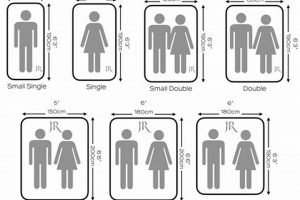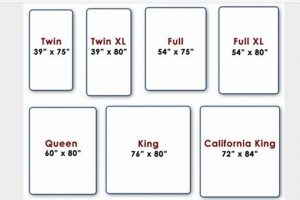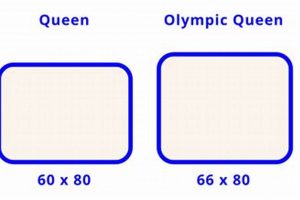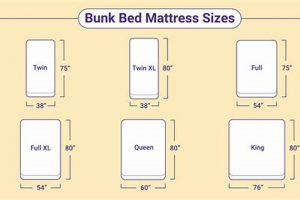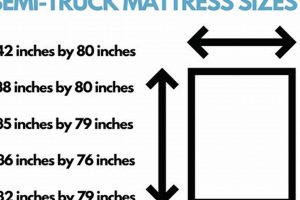Standard bedding dimensions in the United States, when converted to the metric system, provide a consistent and universally understandable measurement. For instance, a common full-size bed, typically 54 inches wide and 75 inches long, translates to approximately 137 centimeters by 191 centimeters. This conversion allows for comparison and comprehension across different measurement systems.
The utility of expressing American bedding dimensions in metric units lies in its global accessibility and standardization. This is particularly relevant in international contexts involving manufacturing, import/export, or when catering to a diverse customer base familiar with the metric system. Historical context reveals a growing trend towards metric adoption in various industries, driven by ease of use and compatibility.
The ensuing discussion will delve into specific dimensions of various bedding options, ranging from crib mattresses to California Kings, presented in both imperial and metric measurements. This information aims to provide clarity and facilitate informed decisions regarding bedding selection and compatibility with existing or planned bedroom layouts.
Guidance on Mattress Dimensions in Metric Units
Optimal bedding selection necessitates precise understanding of available sizes. This section offers guidance to ensure accurate selection and compatibility.
Tip 1: Prioritize accurate measurement of the bed frame or sleeping area before purchasing a mattress. This avoids incompatibility issues and ensures a proper fit.
Tip 2: When comparing dimensions, verify whether the provided measurements include the mattress thickness. Variations in depth can affect overall comfort and fit within the frame.
Tip 3: If sourcing bedding internationally, always confirm the metric equivalent of US mattress sizes to guarantee compatibility with locally available sheets and accessories.
Tip 4: Consider the room size and layout when determining the appropriate mattress size. Larger mattresses may overcrowd smaller spaces, impacting mobility and aesthetics.
Tip 5: Note that slight variations in manufacturing tolerances may exist. A minor deviation from the stated dimensions is typically acceptable but should be verified if precision is critical.
Tip 6: When selecting a mattress for children or individuals with limited mobility, ensure the height allows for easy access and egress from the bed.
Tip 7: For couples, a larger mattress size, such as a Queen or King, may provide improved comfort and reduce sleep disturbance from movement.
Adhering to these suggestions will promote effective mattress selection, ensuring comfort, functionality, and a harmonious fit within the intended space.
The subsequent sections will delve into specific applications and considerations pertaining to various mattress sizes.
1. Twin
The metric dimensions of a Twin mattress, 99 cm x 191 cm, constitute a specific component within the larger context of US mattress sizes as expressed in centimeters. This conversion represents the smallest standard adult mattress size commonly available in the United States, translated into metric units. Its importance stems from providing a standardized and internationally recognized measurement for this specific bedding option. For example, a furniture manufacturer exporting Twin mattresses to Europe would rely on the 99 cm x 191 cm dimension for production and labeling, facilitating smoother transactions and ensuring product compatibility with metric-based bedding accessories.
Understanding the metric equivalent of the Twin mattress size is practically significant in various scenarios. Interior designers working on space-constrained rooms can utilize this dimension to optimize layouts. Individuals purchasing bedding online from international retailers can confidently select the correct size based on metric specifications. Furthermore, institutions such as hospitals or dormitories, which often require multiple Twin mattresses, can leverage this standardized measurement for efficient procurement and resource allocation.
In summary, the “Twin: 99 cm x 191 cm” data point is an integral element of a comprehensive understanding of US mattress sizes converted to centimeters. Its accurate interpretation and application are crucial for various stakeholders, ranging from manufacturers to consumers, to ensure compatibility, facilitate informed decision-making, and promote efficiency in relevant processes. While other mattress sizes offer different dimensions, the Twin size serves as a fundamental reference point within the overall spectrum of US bedding options presented in metric units.
2. Full
The dimensional specification “Full: 137 cm x 191 cm” represents a critical component within the broader classification of United States mattress dimensions expressed in centimeters. It defines a specific mattress size, commonly known as a ‘Full’ or ‘Double,’ utilizing the metric system for precise measurement. As such, it contributes directly to the overall catalog of US mattress options when presented in a globally understandable unit of measure. The cause-and-effect relationship is straightforward: the need for international standardization and communication led to the conversion of standard US mattress sizes into the metric system, with “Full: 137 cm x 191 cm” being one such conversion.
The importance of accurately specifying the ‘Full’ size in metric units lies in its practical application across several domains. For example, a European hotel chain furnishing its US-based properties would rely on this metric equivalent to source appropriately sized mattresses. Similarly, overseas manufacturers producing bedding accessories for the US market require precise metric dimensions to ensure product compatibility. Furthermore, online retailers catering to international customers necessitate accurate metric conversions to facilitate informed purchasing decisions. Inaccurate conversions or a lack of metric specifications would result in mismatched bedding, frustrated consumers, and potentially lost revenue.
In summary, “Full: 137 cm x 191 cm” constitutes a crucial, well-defined element within the larger set of United States mattress dimensions converted to centimeters. Its importance lies in providing a universally understood standard, facilitating international commerce, ensuring product compatibility, and enabling informed consumer choices. The challenge lies in maintaining accuracy in these conversions and promoting widespread adoption of metric specifications within the bedding industry. This accurate metric specification is crucial for the compatibility of bedding accessories purchased online with the “Full” sized mattress within the United States.
3. Queen
The dimensional designation “Queen: 152 cm x 203 cm” represents a specific metric conversion within the established system of United States mattress sizes, converted to centimeters. Its inclusion within this system is predicated on the need for international standardization and clear communication regarding available mattress options. The ‘Queen’ size, a common selection in the US, necessitates a metric equivalent for manufacturers, retailers, and consumers operating within metric-dominant markets. This dimension offers a standardized metric representation of a widely used mattress size.
The accurate translation of the Queen size to 152 cm x 203 cm is vital for several practical applications. For example, furniture importers sourcing bedroom sets from Europe require this precise measurement to ensure compatibility between US mattresses and European bed frames. Likewise, textile manufacturers designing fitted sheets for the US market must adhere to these metric dimensions to guarantee a proper fit. The absence of such standardization would result in mismatched products, increased return rates, and compromised consumer satisfaction. Hotels, particularly those catering to international guests, need to provide clear metric dimensions to allow guests to understand bed sizes.
In summary, “Queen: 152 cm x 203 cm” serves as a crucial component within the broader scope of “us mattress sizes in cm”. Its existence facilitates international commerce, enables accurate product design, and promotes informed consumer choices. While maintaining accuracy in conversions is paramount, the ongoing challenge lies in consistently communicating these metric dimensions across various industries and consumer platforms. This facilitates the specification of bed linens, such as duvet covers and fitted sheets, to conform to the Queen size standard.
4. King
The dimensional specification “King: 193 cm x 203 cm” constitutes a key data point within the comprehensive framework of American mattress sizes expressed in the metric system. This measurement defines the dimensions of a standard King-size mattress using centimeters, thereby providing a globally accessible reference for this particular bedding option. Its relevance lies in facilitating international trade, manufacturing standardization, and informed consumer decision-making within metric-dominant markets.
- Standardization in Global Commerce
The “King: 193 cm x 203 cm” metric conversion allows manufacturers and retailers involved in international trade to accurately specify and market King-size mattresses without ambiguity. For instance, a bedding exporter shipping King mattresses to Europe relies on this metric designation to ensure compatibility with European bed frames and bedding accessories. Failure to adhere to this standard can lead to product incompatibility and increased return rates.
- Manufacturing Precision and Compatibility
For bedding accessory manufacturers, the “King: 193 cm x 203 cm” dimension is crucial for designing and producing fitted sheets, mattress protectors, and other related products that fit King-size mattresses. Precise adherence to these metric measurements ensures that these accessories will properly fit mattresses sold in the US market, regardless of where they are manufactured. This fosters consumer satisfaction and reduces the likelihood of returns due to sizing discrepancies.
- Informed Consumer Purchasing Decisions
The “King: 193 cm x 203 cm” dimension empowers consumers to make informed decisions when purchasing mattresses and bedding accessories, particularly when shopping online or from international retailers. By understanding the metric equivalent of a King-size mattress, consumers can avoid purchasing incompatible products and ensure a proper fit for their existing bedroom furniture. This enhanced understanding promotes consumer confidence and reduces the potential for purchasing errors.
- Architectural and Interior Design Considerations
Architects and interior designers require precise mattress dimensions, including the “King: 193 cm x 203 cm” specification, when planning bedroom layouts. These dimensions inform decisions related to room size, furniture placement, and overall design aesthetics. Accurate metric measurements enable designers to optimize space utilization and create visually appealing and functional bedroom environments that accommodate King-size beds comfortably. The dimension is also important when sourcing or creating custom headboards and bedframes to match the mattress.
The facets discussed underscore the integral role of “King: 193 cm x 203 cm” within the larger context of “us mattress sizes in cm”. This metric conversion provides a standardized, universally understood measurement that facilitates international commerce, enhances manufacturing precision, empowers consumer choice, and informs architectural design. While the imperial system remains prevalent in the United States, the availability of metric equivalents ensures compatibility and clarity within the global marketplace and within specialized domestic contexts. By consistently applying these metric conversions, the industry can promote accuracy, efficiency, and consumer satisfaction across all stages of the mattress supply chain.
5. Cal King
The measurement “Cal King: 183 cm x 213 cm” represents a specific instance within the larger set of United States mattress dimensions converted to the metric system, as referenced by “us mattress sizes in cm”. Its significance arises from providing a standardized metric equivalent for the California King mattress size, a dimension preferred for its added length. The inclusion of this metric conversion facilitates international commerce, manufacturing precision, and informed purchasing decisions for consumers accustomed to the metric system. The requirement for international compatibility and standardization mandates the need for this specific metric conversion within the larger context.
Practical application of this metric conversion is evident across diverse scenarios. Consider a scenario where a European furniture manufacturer intends to market bed frames specifically designed to accommodate US California King mattresses. Access to the “Cal King: 183 cm x 213 cm” metric measurement is essential for ensuring dimensional compatibility between the bed frame and the intended mattress. Similarly, textile manufacturers producing fitted sheets for the US market need precise metric data to guarantee accurate sizing. Furthermore, online retailers catering to international clientele require these metric dimensions to allow prospective buyers to make informed purchasing decisions, mitigating the risk of returns due to size discrepancies. The implementation of accurate conversions prevents consumer dissatisfaction and ensures product usability.
In summary, “Cal King: 183 cm x 213 cm” is a key component within the broader context of “us mattress sizes in cm,” providing a standardized metric representation for the California King mattress size. Its presence enables international trade, facilitates accurate manufacturing processes, and empowers consumer decision-making. Maintaining precise conversions and effectively communicating these metric dimensions across various industry sectors remain crucial for seamless interaction within the global marketplace. The absence of such accurate conversions could lead to product incompatibilities and hinder international commercial activities. The ongoing challenge involves promoting the consistent use of these standardized metric dimensions within all relevant sectors of the bedding industry.
Frequently Asked Questions
The following addresses common inquiries regarding the conversion of United States mattress sizes to the metric system. These answers aim to provide clarity and precision regarding dimensional standards.
Question 1: Why is it necessary to convert US mattress sizes to centimeters?
The conversion facilitates international trade, allows for comparison with metric-based standards, and caters to consumers familiar with the metric system.
Question 2: Are the metric conversions of mattress sizes exact?
The conversions are typically rounded to the nearest whole centimeter for practical application. Minor variations may occur due to manufacturing tolerances.
Question 3: Where can accurate conversions of US mattress sizes to centimeters be found?
Reputable online conversion tools, industry publications, and manufacturers’ specifications provide reliable dimensional data.
Question 4: Do all mattress manufacturers adhere strictly to the stated dimensions?
While standards exist, some manufacturers may have slight variations. Verifying dimensions before purchase is recommended, particularly when sourcing bedding accessories.
Question 5: How does mattress thickness affect the overall metric dimensions?
Mattress thickness is not typically included in the standard length and width measurements. Thickness should be considered separately, especially when fitting sheets.
Question 6: Are there different metric standards for mattress sizes outside the United States?
Yes, mattress dimensions vary globally. When purchasing internationally, confirm that metric specifications align with the intended use.
Understanding the metric equivalents of US mattress dimensions is crucial for global commerce and consumer awareness. This information promotes accuracy and informed decision-making.
The succeeding section will explore the practical implications of these dimensions in real-world scenarios.
us mattress sizes in cm
The preceding discourse has methodically examined the conversion of standard United States mattress dimensions into the metric system, with a specific emphasis on centimeters. The exploration addressed common mattress types, encompassing Twin, Full, Queen, King, and California King sizes, providing their respective metric equivalents. The significance of these conversions for international trade, manufacturing, consumer choice, and architectural considerations was thoroughly underscored, highlighting the practical implications of dimensional accuracy and standardization.
As global interconnectedness continues to expand, the importance of universally understood measurement systems will only intensify. The rigorous application of metric conversions to United States mattress dimensions remains crucial for facilitating efficient commerce, ensuring product compatibility, and empowering informed decision-making across diverse sectors. Continued adherence to, and promotion of, these standards will contribute to a more streamlined and effective global marketplace. Accurate usage of “us mattress sizes in cm” will remain important for both consumers and manufacturers.


